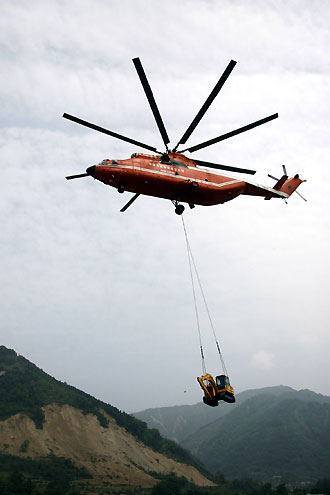Helicopter sector to grow faster
By Xin Dingding (China Daily)
Updated: 2008-06-10 07:35
Updated: 2008-06-10 07:35
Having demonstrated an "irreplaceable" role in the recent disaster-relief efforts in Sichuan province, China's helicopter industry is expected to develop more rapidly in the coming years.
 A rescuer lifts a quake victim stranded in a village in Beichuan county, one of the worst-hit areas in Sichuan Province, onboard a Ministry of Transport helicopter on May 22. [China Daily] |
The May 12 earthquake and subsequent landslides toppled many buildings, blocked roads, destroyed bridges and damaged railways, leaving thousands of people buried under debris waiting for relief.
In the days following the disaster, helicopters demonstrated their unique advantages, which are unmatched by any other means of transportation.
They proved a usefulness beyond that of even fixed-wing planes, because they needed only a few dozen sq m of space to land and take off. In addition, they can hover over one spot and can even move backward, University of National Defense professor Li Daguang explained.
However, currently, the number of helicopters in China is small relative to its geographic size, he added.
According to statistics provided by China Aviation Industry Corporation II (AVIC II) assistant chief engineer Wang Bin, China has about 160 civilian-use helicopters, compared with more than 580 in Brazil, 1,600 in Canada, 3,000 in Russia and 10,000 in the United States.
In addition, only a small number of these are domestically manufactured, and most are imported from the US, Russia and France, he said.
AVIC II is China's only helicopter manufacturer. Its annual production stands at 40 to 50 helicopters of three models in addition to helicopter parts for foreign companies. Most of the production is done at AVIC II's two bases in Harbin, capital of Heilongjiang province, and Changhe city, Jiangxi province.
But only 12 of the more than 100 military and civilian helicopters used in the current disaster-relief efforts were made by AVIC II.
|
||
|
||
|
|
|
|

